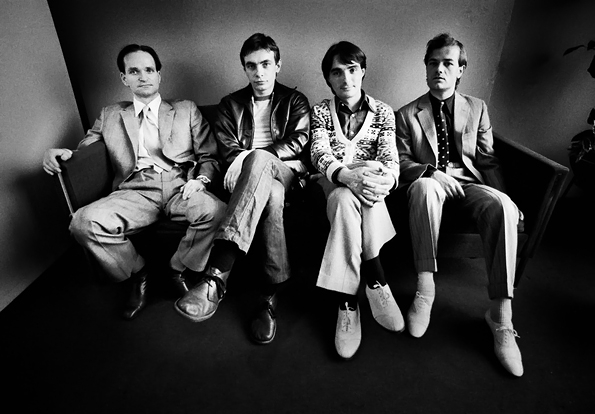‘Electricity’ – The Influence Of Krautrock On The UK’s Next Generation
IMOGEN HARRISON chats with OMD’s ANDY McCLUSKEY about the impact Germany’s musical agitators had on a new breed of English pop stars
It’s West Berlin, it’s 1968, and in a large rented back room in a building along the North bank of the Landwehr Canal, the future is unfolding.
More specifically, this building is the notoriously short-lived Zodiak Free Arts Lab (or Zodiak Club), which is, by day, home to politically-minded theatre group Shaubühne am Halleschen Ufer. It is at night, however, that the majority of the drama takes place – when it becomes an experimental underground live music venue, home to pioneers of psychedelic Krautrock such as Human Being, The Agitation, and, most notably, Tangerine Dream. Painted only in black and white, and littered with new-fangled instruments, speakers and amplifiers that allowed musicians to turn their hand to anything from avant-garde jazz to electronic rock, the audience frequenting the club is a fairly small one, but their belief that “conventional” music is something to be frowned upon means that this isn’t important. What is important is that this “anti-convention” audience is growing, and fast, as musicians such as Conrad Schnitzler, Hans-Joachim Roedelius, Dieter Moebius (the three of whom co-found the club, and later go on to form experimental rock group Kluster), Boris Schaak and Edgar Froese sowed the seeds for a completely new and innovative type of music – known today as Krautrock. It would not only blow their audiences’ open minds with its characteristic improvisation and hypnotic, minimalistic rhythms, but also go on to become highly influential on many genres of music that exist today.
However, although the audience for this new type of music was growing, the majority of Kraut – listeners in the late ’60s were those who had taken part in the ’68 student riots (that had stormed their way across Germany, France and Italy) and who were now looking for fields in which they could indulge in their new-found collective awareness, and even shake off the post-war shame of Hitler and his Nazis. Innovative German rock critic Rolf Ulrich Kaiser had been watching and listening to this new scene unfolding, and was heavily in favour of popularising the genre. Nevertheless, he also realised that without greater mass exposure, it was never going to get off the ground – it would remain labelled as a passing fad, perhaps, or simply as an extension of Anglo-American psychedelia. And that is exactly what this music was not. Whilst American and British rock was generally a development of the blues scale and of the music the slaves had brought with them from Africa in the previous century, Kaiser knew that these songs were innovative, because they were completely different to anything that had come before.
These songs were not just recycled copies of each other, or of Bill Haley’s ‘Rock Around The Clock’. These songs were journeys into the cosmos, avant-garde musical collages of electronic sounds, rock music, and psychedelia (though more in the sense of psychedelic improvisation rather than trying to reproduce the effect of drugs) all merged into side-long suites framed by distorted guitars and lyrics that explored the very foundations of the technology that their writers were playing. Can’s 18-and-a-half minute epic ‘Halleluhwah’ (from Tago Mago, [’71]) features an early form of trance/funk-beats (and therefore had a massive influence on the trance music that would emerge from Germany in the ’90s); ‘Hallucination Guillotine’ by Amon Düül II (featured on their album Yeti, [’70]), and named as “one of the cornerstones of the entire Krautrock movement” by British magazine The Wire) features lyrics about “an assassin…training his soul”; Popol Vuh’s album Kosmische Musik (’70) was the first in history to feature and electronic synthesiser (obviously the vital component in the British synth-pop and new wave movement that was to emerge in the late ’70s/early ’80s).
So, in ’68, Kaiser organised The Internationale Essener Songtage, the first major rock festival in history, in Essen, in order to give these groups the “national recognition that they deserved”. Cited by those involved as “the birthplace of Krautrock”, acts included Amon Düül, Guru Guru Groove, and inevitably Tangerine Dream, amongst others. Also playing were Frank Zappa & The Mothers of Invention, making the festival one of the first times – if not the first time – that an American had been so heavily exposed to the music that was emerging from Germany (bearing in mind the country had generally been ignored in the music world up until that point, in favour of the USA and Britain).
Zappa was obviously influenced in some way by what he heard when he was in Essen; a few months after returning home to LA, he disbanded The Mothers Of Invention, and released his acclaimed solo album Hot Rats (’69), a record full to bursting with distinctly Kraut-sounding solos and instrumentals – the inclusion of which are generally absent on any earlier albums he worked on.
Though Zappa was, of course, only one artist, it is from ’68 onwards that we begin to hear Kraut and electronic influences (such as the widespread use of VCO-based synthesisers) seeping into the work of other British and American chart acts. Pink Floyd’s Dark Side Of The Moon (’73) was incidentally released in the same month as Tangerine Dream’s Atem (the last electronic-driven album for the band before they moved into more commercial territory), with the former’s range of slow atmospheric and more vocally aggressive pieces obviously taking inspiration from the latter (and possibly vice versa). With releases such as NEU!’s self-titled debut (’72), Tangerine Dream’s Phaedra (’73) (an album that earned the group a gold disc in seven countries and reached six-figure sales in the UK, despite virtually no airplay) and, of course, Kraftwerk’s Autobahn (’74) we see Krautrock’s influences becoming even more commercially widespread, influencing the likes of Iggy Pop’s The Idiot (’77), as well as David Bowie’s distinctly minimalistic Station To Station (’76) and inevitably his “Berlin Trilogy” (’77-79), recorded primarily in the Hansa Studio by The Wall in West Berlin, as he took up a more experimental, sporadic style that was so typical of Krautrock.
However, it is with the emergence of a new breed of young British artists (playing their music on newly-available cheap, Japanese synthesisers) in the latter part of the ’70s and the early ’80s, that Krautrock’s influences really begin to hit its heights. In Tubeway Army’s Are Friends Electric?, Orchestral Manoeuvres In the Dark’s Red Frame White Light, and Ultravox’s Vienna, there is another new genre emerging, directly inspired by Kraut. We know it today as synth pop…. or Futurism.

“They were utterly inspiring… they’d made a conscious decision to invent a new European rock ’n’ roll music…”
So speaks Andy McCluskey –front man of revolutionary ’80s synth-pop outfit Orchestral Manoeuvres In the Dark (or OMD) – of Kraftwerk, arguably the most iconic band in the history of world music, and the definitive Krautrock group. Taking the minimalistic instrumental approach pioneered by the likes of Tangerine Dream, Can and Amon Duül II, and pairing it with equally minimalistic, often machine or computer-related lyrics (rather than the sporadic, fantastical lyrics sung by their predecessors), the German group’s influences can be heard in virtually every genre of recognisable music around today have definitely been influenced by Krautrock… that authentic and original electronica kick-started so many great movements around the world).
It is still, however, within the synth-pop grooves that would go on to dominate the charts in the ’80s (in the form of groups like Ultravox, Joy Division and, of course, OMD) that Kraftwerk and Krautrock’s influences can be felt most profoundly.
“It was the 11th September ’75 that I first saw Kraftwerk,” McCluskey proudly says; the fact that he was immediately able to recall the seat number and row in which he sat showing just how deeply the experience of the concert must have ingrained itself in his teenage brain. “Without Kraftwerk or Neu!, OMD wouldn’t have existed,” he continued. “We wouldn’t have had any inspiration. After that Kraftwerk concert, Paul [Humphreys, co-founder of OMD] and I would often go to Probe, the local record store where we lived [in Liverpool], and we’d go straight to the German import section… it really was a voyage of discovery, because that music was so different from anything else we’d ever heard.”
It was this sense of being “different”, of course, that provided the attraction. Just as the first notes of Krautrock had captured the imaginations of European students back in ’68, the industrial, mechanical sound of Kraftwerk grabbed the attention of the mainstream music-buying British public (the majority of whom were caught up in the excesses of glam rock) in ’75, with the release of their definitive record Autobahn. With its catchy melodies and repetitive rhythms, Autobahn peaked at #11 in the British charts, and showed the public that great music could be made without the typical use of guitars, acoustic drums and vocals. Even the record’s sleeve –stark white lines representing the German Autobahns pasted onto a bright blue background – would have been incredibly different to anything else that was around at the time.
Kraftwerk began a tour of the UK in the September of ’75, and despite the public’s reaction to Autobahn, there was no mad rush for tickets. Quite the opposite, in fact; dressed smartly and uniformly in suits rather than sporting an open-necked shirt and jewellery, and playing four synthesisers rather than using typical rock instrumentation, the band were seen by some as a threat to British music. “Spineless, emotionless sound with no variety and less taste” reporter Keith Ging wrote in Melody Maker. “For God’s sake, keep [these] robots out of music.”
There were other groups, of course, that were beginning to release their music in places further afield than their native Germany – Düsseldorf band Neu! and Berlin band Cluster, for example. These groups achieved only limited degrees of success, however, with albums such as Neu! (’75) and Zuckerzeit respectively, and (despite the fact David Bowie references the former on his “Heroes” album) neither of them would go on to have the same amount of mainstream success as Kraftwerk.
Perhaps more importantly, though, it is around this time that we begin to see young British musicians purposefully attempting to emulate the sounds of these German groups. Whilst Andy McCluskey and Paul Humphries were writing songs such as the industrial-sounding ‘Electricity’ (a song that was actually “a homage to Kraftwerk and their technological ideas,” McCluskey says), they were also listening to records like ‘Warm Leatherette’ by English music producer and film editor Daniel Miller, who recorded under the name of The Normal (perhaps ironically so, due to the fact that for a lone British film producer in ’75, this was probably the furthest from “normal” that you could get).
Andy McCluskey agrees: “It was all completely weird, and initially, when we tried to do the same, we didn’t seem to have an audience. I suppose that’s what we set out do to though, really – be different…” He insists, “When Tony Wilson [Head of Factory Records] told us we were ‘the future of pop music’, we were horrified! We didn’t want to be like anyone else…”
This fact is particularly reflected in the band’s choice of name. After seriously considering names such as Queen Victoria’s Funeral and Margaret Thatcher’s Afterbirth, they finally settled on the even more ridiculous Orchestral Manoeuvres in the Dark – a name that they knew would stand out and capture people’s attention, just as names such as Kraftwerk (meaning “power station”) and Neu! (meaning “new” or “modern”) had done. (Interestingly – though unsurprisingly – an early incarnation of OMD was named VCL XI, after a valve number on the sleeve of Kraftwerk’s Radioactivity album. Though they decided not to keep the name (on the grounds that [Orchestral Manoeuvres in the Dark] sounded “a lot more impressive…”), the group did use the name for a track on their ’80 album Organisation, which itself was named after an earlier incarnation of Kraftwerk).
With the emergence of other groups such as The Human League, M, and Depeche Mode in the late ’70s and early ’80s, OMD may have finally begun to realise that they weren’t alone in their love for this synthesiser-driven music; as cheap Japanese synthesisers gradually became more widely available (“It was a bit like the electric guitar thing” McCluskey says. “Suddenly you could get your hands on a synth!”), so did synth-pop records, such as ‘Video Killed The Radio Star’ by The Buggles, ‘New Life’ by Depeche Mode, ‘Are Friends Electric? by Tubeway Army and, of course, the Kraftwerk-esque ‘Messages’ and ‘Electricity’ by OMD.
Listen to any one of these records, or indeed, many of the others released at the time, and you are sure to hear the influences of German Krautrock groups like Kraftwerk in there somewhere; a catchy synth riff, perhaps, or vocals plastered with computer-like effects.
“Kraftwerk are probably the most important band in the history of music,” McCluskey concludes. “And you can quote me on that.”
https://www.youtube.com/watch?v=qBGNlTPgQII
And he is probably right. Not only did Kraftwerk inspire the synth-pop musicians of the ’80s, but by disregarding traditional Anglo-American Blues based music, they opened the door for countless other genres, and kept themselves and their music relevant in the process; House, Techno, Trance, Glitch and Industrial music, Dubstep, EDM, Hip Hop (particularly in terms of sampling and programming) and virtually (so to speak) every other style of modern music you can think of. Whether you like it or not, every Taylor Swift, Katy Perry, Beyoncé and Kayne West song is written, recorded and mixed using computers.
Kraftwerk didn’t just predict the future – “This is the computer world for music and everything else” – they made themselves a part of it.

